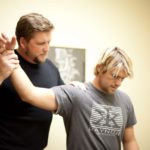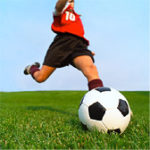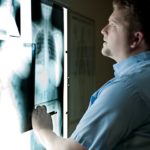The Chiropractic Center is pleased to provide education and information from a variety of trusted, professional resources. Our goal is to increase the knowledge and comfort of our patients across a wide spectrum of interests affecting their health and well being.
If you have specific questions or concerns you’d like to discuss personally with us, please click here . It would be our pleasure to ensure your complete understanding of the science of chiropractic treatments or other subjects covered in the article below.
Gaining an Understanding of Osteoporosis
By John C. Pammer Jr., D.C., D.A.C.B.R
Types
There are two types of osteoporosis: primary and secondary. What determines the existence of either type is the amount of calcium left in the skeleton and whether it places a person at risk for fracture.
Primary osteoporosis can consist of high- and low-turnover osteoporosis. High-turnover osteoporosis (sometimes called type I) occurs in 5 to 20 percent of women, most often between the ages of 50 and 75. This is associated with vertebral fractures and fractures of the hip, wrist or forearm caused by falls or minor accidents. Women have a higher risk for type I osteoporosis than men. Low-turnover osteoporosis (also known as type II or age-related, senile osteoporosis) results when the process of re-absorption and formation of bone are no longer coordinated. Bone breakdown then overcomes bone building.
Secondary osteoporosis, in contrast, is caused by conditions and medications such as: Corticosteroids used by more than 30 million Americans (also called glucocorticoids or steroids). Diuretics, which are used to treat high blood pressure, have different effects on osteoporosis, depending on the type. Loop diuretics, such as furosemide (Lasix), increase the kidneys’ excretion of calcium. Thiazide diuretics protect against bone loss, but this protective effect ends after use is discontinued. Contraceptives that use progestin without estrogen (such as Depo-Provera injection or other progestin-based contraceptives) can cause loss of bone density. Other medications, such as anti-seizure drugs, can increase the risk for bone loss, as can the bloodthinning drug heparin, and hormonal drugs that suppress estrogen. Proton pump inhibitors, which are used to treat gastroesophageal reflux disease (heartburn), may also increase the risk for bone loss and hip fractures. Medical conditions including alcoholism, diabetes, hyperthyroidism, epilepsy, chronic liver or kidney disease, Crohn’s disease, celiac disease, scurvy, rheumatoid arthritis, leukemia, cirrhosis, gastrointestinal diseases, vitamin D deficiency, lymphoma, hyperparathyroidism, and rare genetic disorders such as Marfan and Ehlers-Danlo’s syndrome all increase the risk for bone loss.
Symptoms
All too often, osteoporosis becomes apparent in dramatic fashion: A fracture of a vertebra, hip, forearm or any bony site if sufficient bone mass is lost. These fractures frequently occur after minor trauma, such as bending, lifting, jumping or falling. Pain, disfigurement and debilitation are common in the latter stages of the disease. Early spinal compression fractures may go undetected for a long time, but after a large percentage of calcium has been lost, the vertebrae in the spine start to collapse, gradually causing a stooped posture called kyphosis, or a “dowager’s hump.” Although this is usually painless, patients may lose as much as six inches in height.
Risk Factors
There are a number of factors that predispose a person to osteoporosis;
• Gender. Seventy percent of people
with osteoporosis are women.
• Age. Aging causes bones to thin
and weaken. According to a
report from the Surgeon
General’s office, half of all
Americans over age 50 could be
at risk for this condition by 2020.
• Ethnicity. Although adults from all
ethnic groups are susceptible to
developing osteoporosis,
Caucasians and Asians face a
comparatively greater risk.
• Body type. Osteoporosis is more
common in people who have a
small, thin body frame and bone
structure.
• Family history. People whose
parents had a history of fractures
may be more likely to have
osteoporosis.
• Hormonal deficiencies. In
women, estrogen deficiency is a
primary risk factor. In men, a low
level of testosterone increases
risk. Certain medical conditions
(hypogonadism) and treatments
(prostate cancer androgen
deprivation) can cause
testosterone deficiency.
• Lifestyle factors. These include
dietary factors, exercise, smoking
and alcohol use.
Diagnosing the Condition
Because osteoporosis can occur with few symptoms, testing is important. Bone density testing is recommended where there is long term use of medications; history of treatment for prostate cancer or breast cancer; history of medical conditions such as diabetes, thyroid imbalances, estrogen or testosterone deficiencies, early menopause, anorexia nervosa, rheumatoid arthritis; significant loss of height; and significant recent weight loss or low body mass index. The standard technique for determining bone density is a form of bone densitometry called dualenergy X-ray absorptiometry (DXA). DXA is simple and painless and takes 2 to 4 minutes. The results of this test are usually reported as a “T score” and “Z score.” The T score compares bone density with that of healthy young women, while the Z score compares bone density with that of other people of similar age, gender and race. In either score, a negative number means thinner bones than the standard. A T score below -2.5 indicates osteoporosis.
Delaying Complications
Weight-bearing exercises, both high and low impact, can be beneficial in delaying the complications from loss of bone density. While high-impact exercises are best for building bones, low-impact exercises can also help avert bone loss and are safer for people who cannot do high-impact exercises. Walking can be one of the best options. Agriculture Department scientists found that women who walked more than 7.5 miles a week can delay complications from loss of bone density better than non-walkers. In addition, resistance and strengthening exercises including using weight or resistance against gravity can be beneficial as can nonimpact activities, such as wobble boards, yoga and dancing.
• National Osteoporosis Foundation. Available
at www.nof.org/osteoporosis/stats.htm
• Lewiecki Michael, MD. New Mexico Clinical
Research & Osteoporosis Center,
Albuquerque
• Dornemann TM, McMurray RG, Renner JB,
Anderson JJ. Effects of high-intensity
resistance exercise on bone mineral density
and muscle strength of 40-50-year-old
women. J Sports Med Phys Fitness
1997;37:246-251
• Kaptoge S, Armbrecht G, Felsenberg D,
Lunt M, O’neill TW, Silman AJ, Reeve J;
Epos study group
• www.nia.nih.gov/exercisevideo







